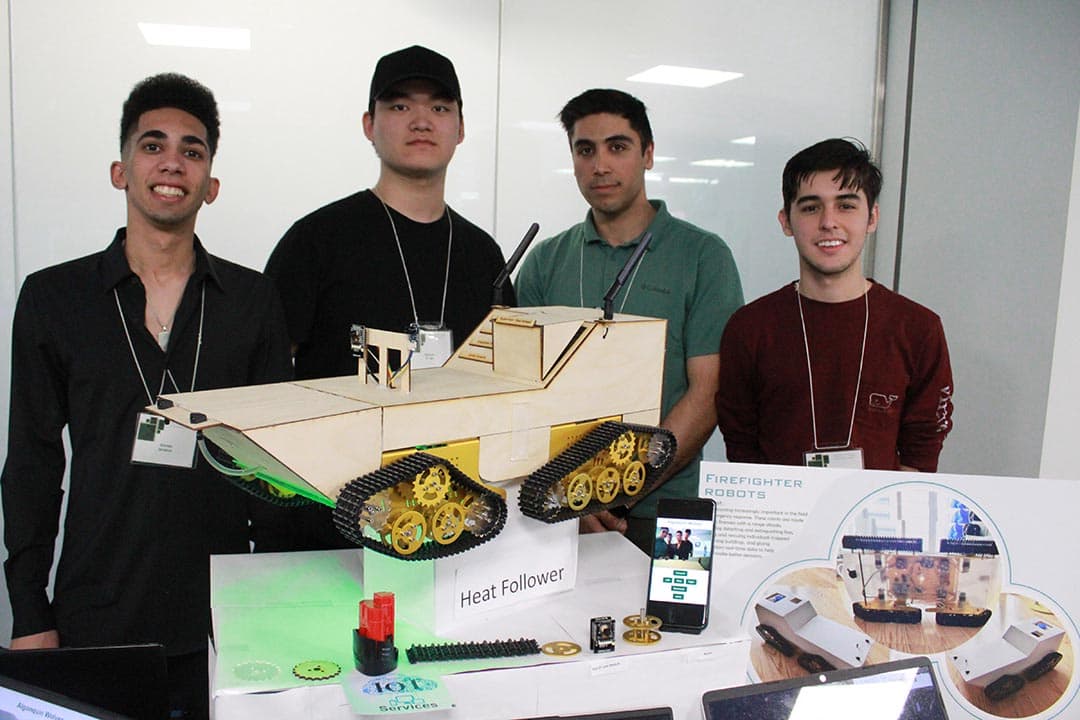Student innovators pitch their products at RE/ACTION showcase

Firefighting drones. Smart armour. Mic blockers. It all sounds like stuff out of a movie, but they were very real at RE/ACTION last week.
This event allowed students to share ideas, network, possibly build a client base, gain access to video presentation skills and pitch session workshops.
It gave students an opportunity to have potential media coverage and receive feedback from industry professionals. The event was organized by Algonquin’s Office of Applied Research, Innovation and Entrepreneurship.
Students let faculty, Ottawa-based companies and other students come down to the first floor of C-building to have a look at their products on April 14.
It was also a chance for local companies to scout fresh talent and examine students’ skills.
People zig-zagged around the tables and inquired about the innovations that students had tirelessly researched and developed throughout the academic year.
One was the “Firefighter Robot” designed by Eshan Noei, Huanan Qiao, Chris Pinera and Ahmed Ibrahim.
The robot is controlled manually and has two micro-controllers, which are super small computers. One of them is a tiny camera module that assists with manual control through a laptop. It could also be controlled through a phone, tablet or any device with an internet connection.
“You can go into a dangerous area and it can send you a video livestream or information to any kind of sensor that you connect to,” Noei said.
But this robot has a trademark: an automated feature which comes through a thermal sensor. It connects the sensor to those super small computers. Then, they process the sensor and adjust the robot to find the heat and spray it with water.
Most people will call it a heat sensor, but Noei prefers to think of it as a “heat follower.” He believes there is room to improve this project. For now, it’s a firefighter robot, but it can be applied on a bigger scale.
The robot is versatile and can be manipulated to fit the customer’s needs, as Ibrahim explained. “We can improve it to whichever situation. If it’s going to be used as a firefighter, we can change its material from wood to carbon fibre. It just depends on what a company will use it for,” he said.
Pinera said some companies approached the team and expressed their approval.
“They think it’s a good design. They said it will help the fire departments with search and rescue and could be used for other governmental uses,” Pinera said.

Over at table eight was the “Martial Arts Training Application and Body Armour” developed by Neil Kingdom, Hussein Abdullahi, Rocco Bahagwandin and Younes Berrada, a team of computer and electrical engineering students.
“Our client owns a martial arts dojo in London, Ont. and they do very hard-hitting karate there, so they wear this body armour for protection while they’re sparring. He wanted a way for his students to be able to measure their progress while they were training, so we put some sensors inside the armour and we created a mobile application that communicates over Bluetooth. It reads how hard you hit the sensors as well as kind of a general area of where you hit,” Kingdom said.
Kingdom and his team spent four months in planning then four months executing.
Abdullahi said the team wants to possibly explore markets in the future.
“It’s a pretty niche market. There’s not a lot of competitors producing body armour like this where you can get info on how hard your hitting and where your hitting,” he said.
There was also a “Cone of Silence” by electrical engineering students Caleb Smith and Adam Cacciotti.
“It’s basically a device that emits ultrasonic waves which disrupts the mic component on a digital device. So, if you’re having a conversation with anyone and let’s say you have an Alexa in the background, it won’t be able to hear your conversation. That way, you won’t have any ads pop up referring to what you were just saying,” Smith explained.
Smith and Cacciotti are trying to achieve a product that will land on the market later on and be accessible to everyone.
“I think it’s a pretty good niche,” Cacciotti said. “Our client is hoping to get a Kickstarter going once we’re done with the design and everything.”








